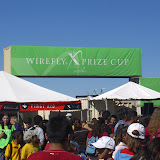The nice dude in the campsite next to ours has started a company to send postcards to space, and you can do it for only $25!

He talks about the experience of X Prize Cup here. Mike, Kevin, and I get a mention :-)
--------
SI Time Capsule
A cool time capsule project by Yahoo! and the Smithsonian Institute.
--------
NSS Space Settlement Calendar Art Contest
From the NSS website:
"The National Space Society (NSS) is looking for artists to create visions of a spacefaring future — a future of space settlement, be it on the Moon, on Mars, on asteroids, or orbiting independently in space. To bring attention to our goal of creating a spacefaring future, NSS is sponsoring a contest for such artwork to be used in a calendar promoting a future of humans living and working in space. The best of the submitted artwork will be selected for inclusion in the 2008 NSS Space Settlement Calendar. "
--------
Fly Your Name to Mars on Phoenix
From the Planetary Society website:
"Simply fill out the form below and your name will be included on the Phoenix DVD along with Visions of Mars, a collection of Mars literature and art, and personal messages to the future by space visionaries of our time such as Carl Sagan, Isaac Asimov, Ray Bradbury, and Arthur C. Clarke."



